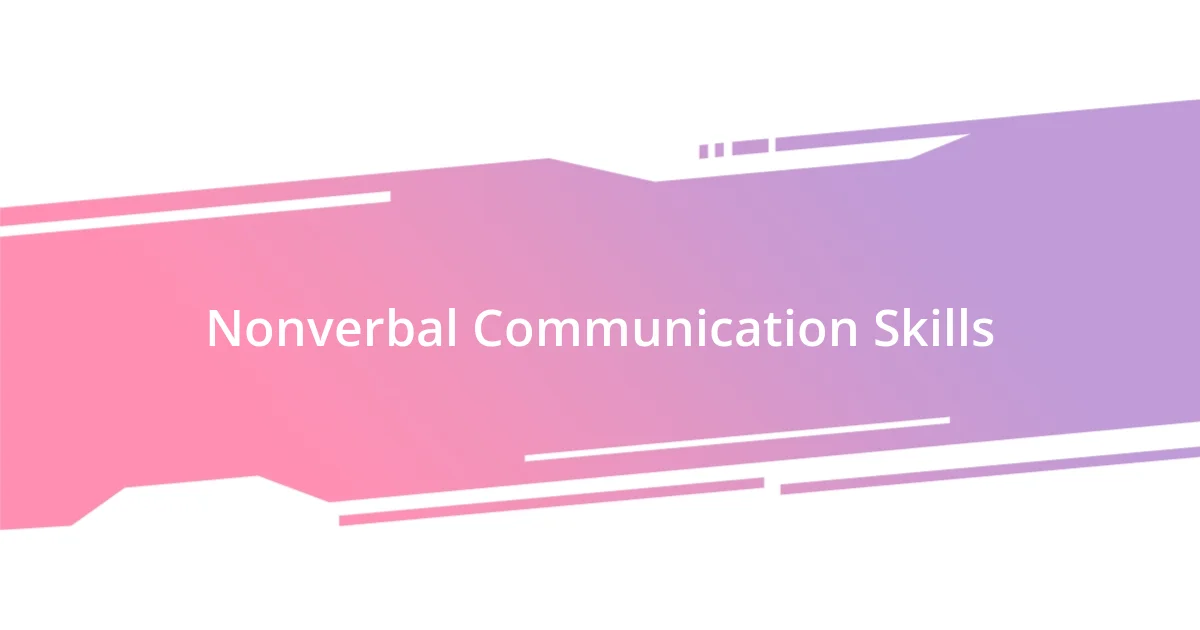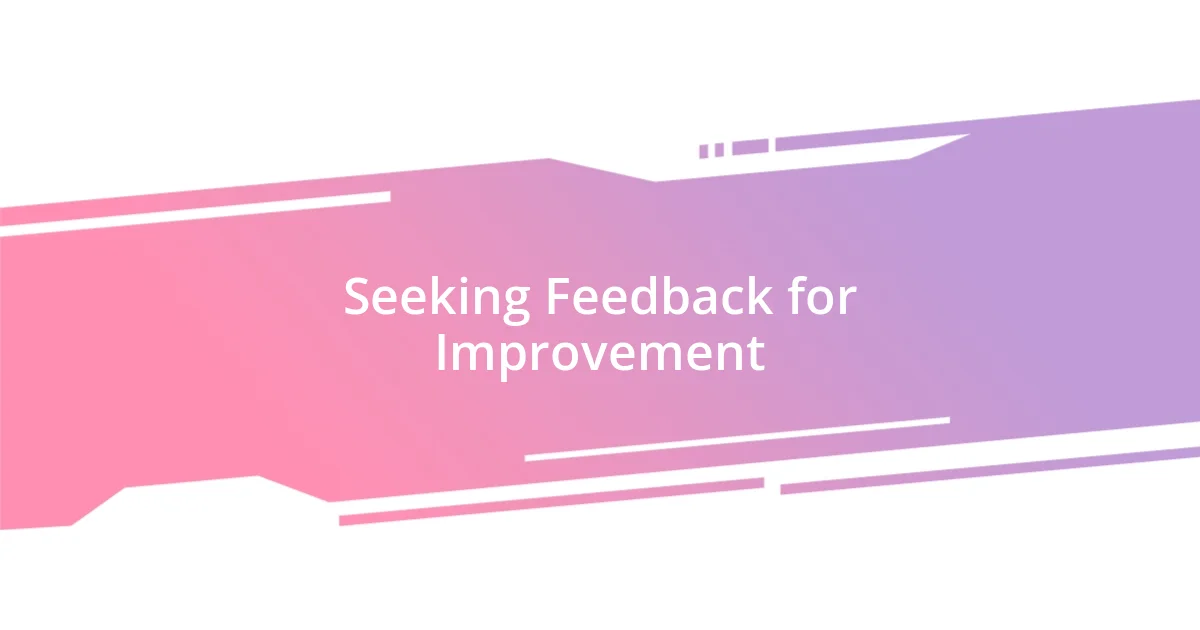Key takeaways:
- Effective communication involves both clarity and active listening, fostering stronger relationships and engagement.
- Nonverbal cues and assertive communication greatly influence interactions, helping to convey empathy and establish boundaries.
- Seeking feedback enhances communication skills, creating a culture of openness and collective growth within teams.

Understanding the Importance of Communication
Communication is more than just exchanging words; it’s about connecting on a deeper level. I remember a time in my early career when I misunderstood the expectations of my supervisor due to vague instructions. That experience taught me that clarity in communication not only prevents confusion but also fosters stronger relationships.
Have you ever noticed how a simple conversation can change the atmosphere in a room? I’ve seen it happen during team meetings where one person’s insightful comment ignited a passionate discussion, transforming a stagnant project into a collaborative effort. This power of communication to engage and motivate others is something I’ve come to appreciate deeply.
In my personal journey, I’ve realized that effective communication builds trust. For instance, after I started actively listening to my friends and family, I noticed they began to open up more. Reflecting on this, I can’t help but ask—how much can our relationships improve just by making the effort to communicate better? This realization continues to shape my interactions every day.

Identifying My Communication Gaps
Recognizing my communication gaps was a bit like holding up a mirror to myself. At times, I would ramble during conversations, not realizing that my listener was lost long before I reached my point. A specific instance comes to mind; during a group project, I presented my ideas with so much enthusiasm that I neglected to gauge my team’s reactions. They were nodding off instead of engaging. That moment forced me to confront the importance of balance—how to express my thoughts clearly without overshadowing others’ contributions.
To pinpoint my communication challenges, I started reflecting on the following aspects:
- Listening Skills: Was I truly absorbing what others were saying, or was I just waiting for my turn to speak?
- Clarity: Did my words convey my thoughts effectively, or did I leave room for misinterpretation?
- Non-verbal Cues: How aware was I of the body language and expressions of those around me?
- Feedback: Was I soliciting and embracing feedback from others about my communication style?
- Empathy: Was I considering the emotional context and perspective of my listeners during conversations?
Acknowledging these gaps and actively working on them has truly reshaped how I communicate, making it a more enriching experience for everyone involved.

Techniques for Active Listening
Active listening is one of the most crucial techniques I’ve embraced in my journey towards better communication. It’s not just about hearing words; it’s about truly understanding and engaging with the speaker. For example, during a recent conversation with a colleague, I made a conscious effort to paraphrase what they said. This simple act helped to clarify their thoughts and made them feel acknowledged. It was rewarding to see their relief; they appreciated that I valued their perspective.
One of the techniques I found particularly helpful is maintaining eye contact. Initially, I struggled with this, often looking away or getting distracted by my surroundings. However, by focusing on the speaker and giving them my undivided attention, I noticed a significant change in the quality of my interactions. I remember attending a networking event where I utilized this technique. It made conversations more engaging, and I felt more connected to the people I met.
Finally, asking open-ended questions contributes significantly to active listening. This technique allowed me to dig deeper into topics and understand the emotions and motivations behind what was being said. In a recent discussion with a friend about their career changes, I asked open-ended questions like, “What are your thoughts on this new opportunity?” These questions encouraged them to express their feelings and challenges, bringing us closer and fostering a supportive dialogue.
| Technique | Description |
|---|---|
| Paraphrasing | Restating what the speaker has said to confirm understanding and show engagement. |
| Eye Contact | Maintaining eye contact to show attentiveness and create a connection. |
| Open-Ended Questions | Asking questions that require more than a yes or no answer to explore deeper feelings and thoughts. |

Nonverbal Communication Skills
Understanding nonverbal communication has been a game changer for me. I remember a meeting where I confidently presented my ideas, but the crossed arms and downcast eyes of my teammates told a different story. It made me realize that my message wasn’t just in my words, but also in the energy and expressions around me. How often do we overlook what isn’t being said out loud?
I began to pay closer attention to my own body language. One time, while discussing project deadlines, I leaned in and showed open palms. This simple shift seemed to invite collaboration rather than opposition. I felt the atmosphere change as my colleagues became more participative. Suddenly, the room buzzed with ideas, and it highlighted just how much nonverbal cues can influence the dynamics of any conversation.
Facial expressions can also communicate powerful stories. During a casual chat with a friend, I noticed their smile faded as I spoke about a tough week. That moment clicked for me—expressing warmth and empathy through my own facial reactions can make a significant difference. It’s not just about being interested; it’s about showing that I care. Have you ever had a moment when you felt seen and understood just because someone mirrored your emotions with their expressions? It’s truly transformative.

Practicing Assertive Communication
Practicing assertive communication has been a crucial pillar in my development. I remember a time in a group project where I hesitated to share my ideas, fearing they might not be well-received. This experience was eye-opening. When I finally found the courage to express my thoughts clearly, I received positive feedback, which encouraged me to continue being vocal about my perspectives. Isn’t it fascinating how our own doubts can hold us back from contributing to something bigger?
I also learned the importance of using “I” statements as part of assertive communication. Instead of saying, “You always interrupt me,” I began saying, “I feel overlooked when I’m interrupted.” This shift not only helped me express my feelings without sounding accusatory but also fostered a more collaborative atmosphere. Have you ever noticed how the way we frame our concerns can change the response we get? It’s such a subtle yet powerful technique.
Moreover, I practice setting boundaries in conversations. There was a day when a colleague went on a tangent during a meeting, and instead of letting it derail our agenda, I made a gentle interjection. I said, “I appreciate your insights, but can we steer back to the main topic?” This felt liberating for me and signaled to others that respecting time is essential. It was a learning moment; asserting myself in such situations not only helped maintain focus but also inspired others to be more mindful of the discussion. Isn’t it amazing how asserting ourselves can create an environment where everyone feels respected?

Seeking Feedback for Improvement
Seeking feedback has been one of the most transformative steps in my journey to better communication. I distinctly remember asking a trusted colleague for their thoughts after a presentation. They highlighted not just the strengths of my delivery but also suggested areas for improvement, like my pacing. Have you ever wondered how much we can grow from the insights of others?
I’ve also learned to seek feedback proactively, rather than just waiting for it to come my way. After a brainstorming session, I made it a habit to ask my team, “What could I have done differently?” The responses often surprised me, opening my eyes to blind spots I hadn’t even considered. This practice has not only enriched my skills but has created a culture of open dialogue in our team. Isn’t it incredible how initiating these conversations can lead to collective growth?
Most importantly, I discovered that vulnerability plays a vital role in receiving feedback. When I openly expressed my desire to improve, my colleagues felt more comfortable sharing their thoughts. It’s a bit like ripples in water; my willingness to be open encourages others to engage in honest conversations. Have you experienced that moment when someone’s honest feedback changed your perspective entirely? It’s a humbling yet powerful experience that propels growth forward.














